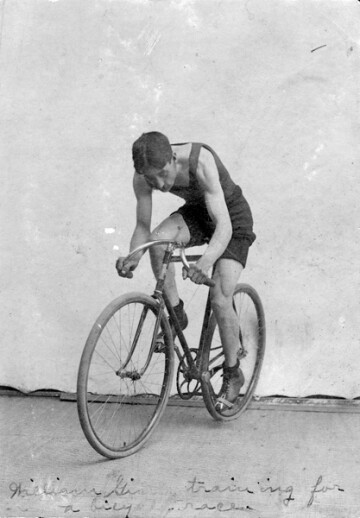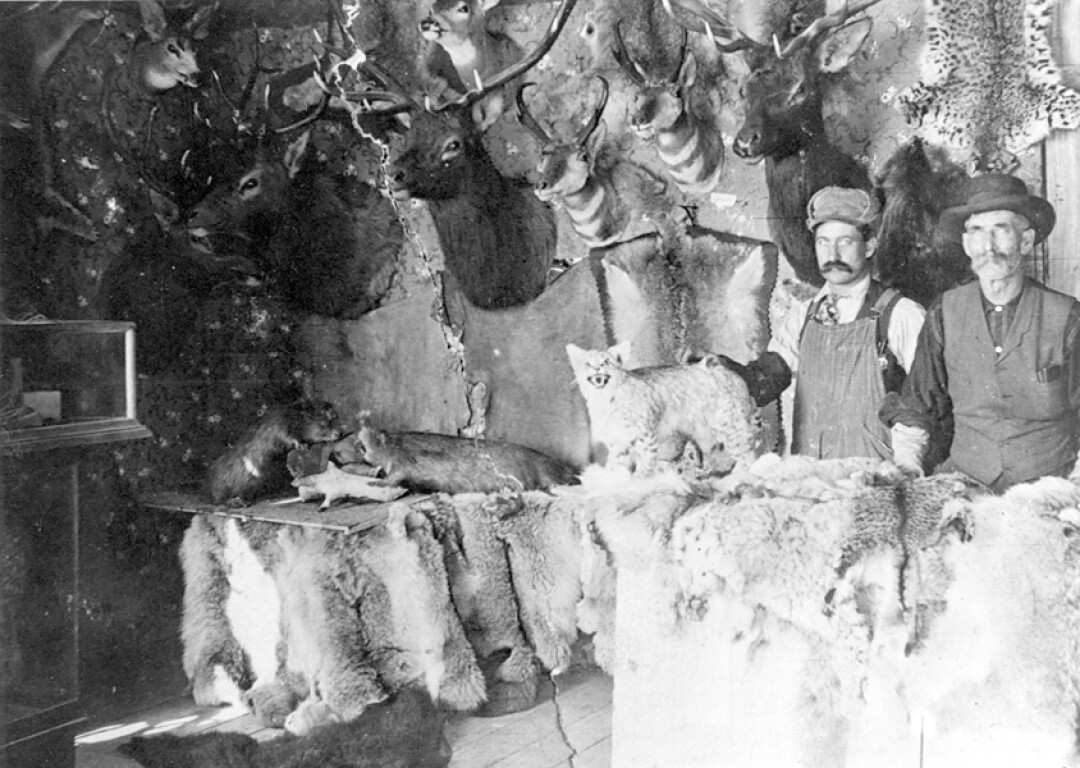Bicycles & Taxidermy
In a century-old photograph, William Ginn proudly poses with six gigantic trout, a hint of a smile on his lips and a sparkle in his eyes. In another image, he is propped up on a bicycle in front of a curtained backdrop, muscles straining for the camera. Bozeman businessman William Ginn truly loved the outdoors. Bicycling, fishing, hunting, and taxidermy captured Ginn’s fancy, and his passions were burned into photographs that speak of days gone by.
In the early 1900s, Bozeman vied with Livingston to provide the biggest and most spectacular Fourth of July event. Today, we think of our neighbor over the hill as the destination for Independence Day festivities, but there was a time when Bozeman held its own. Parades, fireworks, orations, feasts, games, and dances often spilled over into a two-day party. Some of the most popular events were the bicycle races.
At the turn of the twentieth century, the local long-distance cycling champion was a future civic leader named Frank Wilton. Wilton arrived in Bozeman in 1893 and remained a prominent businessman in town until his death in 1939. He worked for the Northern Pacific Railroad and the Willson Company, and eventually launched his own store, Wilton’s Fashion Apparel. Frank worked hard and was a talented cyclist. He was also about to get the race of his life.
William Ginn was a 25-year-old Bozeman newcomer with a young family and a knack for mechanics. Born in Iowa and raised in South Dakota, Ginn himself was an avid bicyclist and loved competition. In July of 1901, both Frank and William entered the grueling five-mile road race that highlighted Bozeman’s Fourth of July athletic contests.
Race day dawned, and each rider prepared for the big event. The Avant Courier later exclaimed: “[the] race put to the severest test the strength and physical endurance of those who entered it, and it was intensely exciting, too.”
To the thrill of the spectators, Ginn out-rode Frank Wilton and won. People remembered this event for decades to come. According to his obituary in the July 26, 1946 Avant Courier newspaper, “He was well known in his early days in Bozeman as a bicyclist [sic] and took part in the racing sport. The day he out-distanced Frank Wilton, the champion, was a big event.”
William continued his strong performance the next year at the 1902 Fourth of July races. Showing his talent for speed as well as endurance, he edged out Wilton again, this time in the shorter half mile dash. Ginn secured victories in the one-mile handicap and the one-mile consolation race, cementing his reputation as one of Bozeman’s finest competitive cyclists.
At the turn of the twentieth century, bike travel was popular in Bozeman. Streetcars clattered around town every day, but cycling held a certain charm. Some of Bozeman’s first city ordinances regarding bicycle use were introduced in 1901. Initially, people were only prohibited from riding bikes on Main Street’s wooden sidewalks, but this law soon expanded to walkways all over the city. As the Avant Courier noted on June 29, 1901, “Bozeman is the only city in this state where wheeled vehicles are accorded the privileges of the sidewalk, and the city council in according that privilege, in all probability transcended its authority.” Main Street was finally paved with cement in 1908, undoubtedly a great event for cyclists, who no longer had to contend with wheel ruts, dust, and mud.
Taking advantage of the contraption’s popularity, William Ginn decided to turn his talent into a career. Soon after his arrival in Bozeman, Ginn opened his own bicycle repair shop, one of the first such establishments in town. William’s father, James, assisted for several years, and the two men ran their operation from a shop on Main Street. His business later expanded to include automobile repair, and William enjoyed a 20-year career as a mechanic.
William Ginn was a well-rounded outdoorsman, and other activities also caught his fancy. Like many locals today, he hunted and fished in the streams and hills around southwest Montana. Photographs document several of Ginn’s excursions, providing a glimpse of early angling and hunting activities.
Madison River fishing was quite popular in the first half of the 1900s, and remains so today. W. J. Thompson of the Bozeman Fisheries Station expounded on the virtues of this waterway in a letter to one Walter D. Warrick of Chicago, dated July 1, 1931. “This Madison is one of the greatest fishing streams of the west, yet at the same time it might be difficult to land a big one just when you were in the humor; strangely enough, the big ones are not always in that frame of mind when you are.” If Ginn’s fishing photos are any indication, angling on the Madison River was indeed good at the turn of the twentieth century. 
Back then, hunting differed as well. Recreation took second place to acquiring food, although hunters like William enjoyed the sport involved. In 1910, Ginn mailed one of his hunting photo-postcards to a friend in South Dakota. He wrote: “Well Major here I am & Mr. Johnson. We both went Elk Hunting & got our limit in Elk. 2 Day Hunting, I got the Bull. Six Points & now we are Eating fine Elk Stakes [sic] & Roasts.” William Ginn appreciated more than “Stakes & Roasts”. Something about the “Six Points” also attracted him.
As with his cycling passion, William Ginn managed to incorporate an outdoor activity into a money-making venture. In addition to (and for a time along with) his bicycle shop, Ginn and his father ran a thriving taxidermy business. In a photograph taken about 1901, the two men pose proudly behind a pelt-covered counter in a shop filled with hanging hides and mounted deer, elk, and pronghorn. Ginn’s passion for taxidermy must have rivaled his fondness for cycling. William’s obituary proclaims: “He also was a taxidermist and there are mounted elk and deer heads all over the country that testify to his craftsmanship.”
William Ginn passed away in Bozeman in July of 1946 at the age of 70, survived by his wife of nearly 50 years, Ida, and five of their six children. He lived an eventful life, filled with bicycles and taxidermy.

